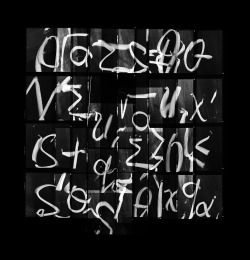| Paul Berger, Pictures |
|

MATHEMATICS SERIES, 1976-77
I photographed the blackboards of the mathematics department of the University of Illinois in Urbana/Champaign. Daily, hourly, these boards are filled with symbols and diagrams: within that context, the hand-drawn symbols and diagrams need only point to corresponding mathematical concepts and their ordering; the visual properties of the marks that compose the symbols are not significant.
To this arena, I applied a specific camera operation. By partially advancing the 120 film between exposures, the roll of film became not a series of distinct and isolated frames, but a series of multiple image strips which varied in length by the number of exposures that composed them. This way of using film is not in itself an innovation, but rather a stance on what a photographic image can picture. In the continuous field of the single image photograph, the visual cues that indicate form, depth and scale depend on the simultaneous recognition of camera perspective, size relationships of known objects and surfaces, and tonal rendering of those objects and surfaces. When the separate exposures are overlapped as in these strips, the collision of perspectives, size relationships, and tonal renderings within shared areas creates "illusions" of form, depth, and scale that can extend, complement, run counter to, or depart from what is pictured within each individual frame. Thus the strip pictures what cannot be seen were we to isolate each frame, but does so in the same terms as the single image photograph: perspective, scale, tone.
These strips were juxtaposed by contact printing and became the functional units of the final print. In the first 20 prints, the strips are in groups of three and printed adjacent to each other; in the last 15, the strips are in groups of two, three, and six, and are printed both adjacent to and overlapping each other. Through the overlap and/or adjacency of the strips, the final print can extend, complement, run counter to, or depart from what is pictured within each individual strip. Consequently, the strips function within the print as the frames function with the strip.
The prints are exhibited in a sequence, ordered in terms of increasing complexity so that one print can be understood in terms of previous prints. The frame, the strip, the print, and the sequence form the context of the work. It is within this context that the visual properties of the blackboard marks become significant.
Paul Berger
May 1977
I photographed the blackboards of the mathematics department of the University of Illinois in Urbana/Champaign. Daily, hourly, these boards are filled with symbols and diagrams: within that context, the hand-drawn symbols and diagrams need only point to corresponding mathematical concepts and their ordering; the visual properties of the marks that compose the symbols are not significant.
To this arena, I applied a specific camera operation. By partially advancing the 120 film between exposures, the roll of film became not a series of distinct and isolated frames, but a series of multiple image strips which varied in length by the number of exposures that composed them. This way of using film is not in itself an innovation, but rather a stance on what a photographic image can picture. In the continuous field of the single image photograph, the visual cues that indicate form, depth and scale depend on the simultaneous recognition of camera perspective, size relationships of known objects and surfaces, and tonal rendering of those objects and surfaces. When the separate exposures are overlapped as in these strips, the collision of perspectives, size relationships, and tonal renderings within shared areas creates "illusions" of form, depth, and scale that can extend, complement, run counter to, or depart from what is pictured within each individual frame. Thus the strip pictures what cannot be seen were we to isolate each frame, but does so in the same terms as the single image photograph: perspective, scale, tone.
These strips were juxtaposed by contact printing and became the functional units of the final print. In the first 20 prints, the strips are in groups of three and printed adjacent to each other; in the last 15, the strips are in groups of two, three, and six, and are printed both adjacent to and overlapping each other. Through the overlap and/or adjacency of the strips, the final print can extend, complement, run counter to, or depart from what is pictured within each individual strip. Consequently, the strips function within the print as the frames function with the strip.
The prints are exhibited in a sequence, ordered in terms of increasing complexity so that one print can be understood in terms of previous prints. The frame, the strip, the print, and the sequence form the context of the work. It is within this context that the visual properties of the blackboard marks become significant.
Paul Berger
May 1977
